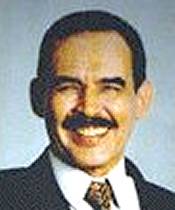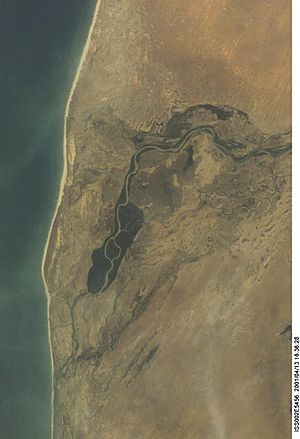Maaouya Ould Sid'Ahmed Taya facts for kids
Quick facts for kids
Maaouya Ould Sid'Ahmed Ould Taya
|
|
|---|---|
|
معاوية ولد سيد أحمد ولد الطايع
|
|

Al-Taya in 2003
|
|
| 5th President of Mauritania | |
| In office 12 December 1984 – 3 August 2005 |
|
| Preceded by | Mohamed Khouna Ould Haidalla |
| Succeeded by | Ely Ould Mohamed Vall |
| 5th Prime Minister of Mauritania | |
| In office 25 April 1981 – 8 March 1984 |
|
| Preceded by | Sid'Ahmed Bneijara |
| Succeeded by | Mohamed Khouna Ould Haidalla |
| In office 12 December 1984 – 18 April 1992 |
|
| Preceded by | Mohamed Khouna Ould Haidalla |
| Succeeded by | Sidi Mohamed Ould Boubacar |
| Chief of Army Staff | |
| In office 15 July 1980 – 26 March 1981 |
|
| Preceded by | Ahmedou Ould Abdallah |
| Succeeded by | Yall Abdoulaye Alassane |
| In office 8 March 1984 – 12 December 1984 |
|
| Preceded by | Yall Abdoulaye Alassane |
| Succeeded by | Ahmedou Ould Abdallah |
| Personal details | |
| Born | 28 November 1941 Atar, French Mauritania |
| Political party | Democratic Republican Party for Renewal (PRDS) |
| Military service | |
| Branch/service | Mauritanian Army |
| Years of service | 1961–1992 |
| Rank | Colonel |
| Battles/wars | Western Sahara War |
Maaouya Ould Sid'Ahmed Ould Taya (born 28 November 1941) is a military officer and politician from Mauritania. He was the President of Mauritania from 1984 to 2005. He also served as the Prime Minister of Mauritania for many years, starting in 1981.
Ould Taya was born in Atar, which was then part of French Mauritania. He studied at military schools and later took part in the Western Sahara War. He became the Chief of the Army staff in 1980 and then Prime Minister in 1981. He became president after a peaceful military takeover in 1984.
During his time as president, he focused on strengthening ties with Arab nations and the United States. He was removed from power by another military takeover in 2005.
Contents
Early Life and Education
Maaouya Ould Sidi Ahmed Ould Taya was born on 28 November 1941. His hometown was Atar, in what was then called French Mauritania. He went to a Franco-Arabic Primary School from 1949 to 1955. After that, he attended Rosso High School in southern Mauritania.
In 1960, he joined a French military school and became an officer the next year. He received special training in military strategy in 1975. In 1978, the Mauritanian Army took control of the government. This happened during the Western Sahara War, a conflict over the Western Sahara region. Ould Taya was part of this group and quickly became important in the new government.
Becoming President (1984–2005)
Ould Taya held several important jobs in the military. In July 1980, he was made Chief of Staff of the Army. This was during the time when Mohamed Khouna Ould Haidalla was the military leader of Mauritania.
In March 1981, there was an attempt to overthrow Haidalla, but it failed. After this, Ould Taya was chosen as Prime Minister on 25 April 1981. He took over from Sid Ahmed Ould Bneijara. Ould Taya stayed in this role until 8 March 1984. At that point, Haidalla, who was still the head of the country, took over the Prime Minister job himself.
On 12 December 1984, while Haidalla was out of the country, Ould Taya took control. He announced that he was the new leader of the Military Committee for National Salvation.
Dealing with Border Issues
In April 1989, there were problems between different groups of people in Mauritania. This led to a serious disagreement between Mauritania and Senegal over their border.
Even before this, Ould Taya and Abdou Diouf, the president of Senegal, had argued about dams built on the Senegal River. Ould Taya believed that Mauritania was not getting fair access to the river.
The growing tensions between ethnic groups made the situation worse. The Mauritania–Senegal Border War began after a conflict between Mauritanian herders and Senegalese farmers. The border between the two countries was then closed, and they stopped talking to each other.
As the conflict continued, some people from the Fula and Soninke groups were arrested. In July 1991, presidents Diouf and Ould Taya agreed to stop fighting. They signed a peace treaty on 18 July. The border between Mauritania and Senegal reopened to everyone on 2 May 1992.
Foreign Policy and Global Ties
In the late 1980s, Ould Taya worked closely with Iraq. He strongly supported Arab nationalism, which is a belief in the unity of Arab people. Mauritania became more isolated from other countries. Tensions with Western nations grew when Mauritania supported Iraq during the Gulf War. This was despite the fact that France had given Mauritania support and aid earlier.
On 28 October 1999, Mauritania became the fourth Arab League member to officially recognize Israel. This meant Ould Taya formally ended a conflict with Israel that had started in 1967.
During his time in office, Ould Taya also started working with the United States on fighting terrorism. This policy was not popular with everyone. His closer ties with Israel and the United States led to more opposition against his rule.
Moving Towards Democracy
Ould Taya's government started to move towards a system where people could vote for their leaders and have different political parties. A new Constitution was approved by a vote in July 1991.
The first multiparty presidential elections were held in January 1992. Ould Taya ran as the candidate for the new Democratic and Social Republican Party (PRDS). He won with almost 63% of the votes. However, other political parties claimed there were many problems and cheating in the election. He won again in the 1997 presidential election with over 90% of the votes. Many major opposition parties did not take part in this election, saying it would be pointless because of expected fraud.
Challenges in Later Years
The last years of Ould Taya's rule were difficult. There was unrest within the military and disagreements between his government and some religious groups. Ould Taya changed his stance on Iraq and became closer to Western countries.
In June 2003, Ould Taya's government faced an attempt to overthrow it. Rebel soldiers fought for two days in the capital city, Nouakchott. The government managed to defeat them. In November 2003, another presidential election was held. Ould Taya won with over 67% of the votes. Again, the opposition said the results were not fair.
In November 2004, Ould Taya announced that government workers and retired people would get more pay. This was because he expected the country to earn more money from natural resources, especially oil found offshore.
Overthrow and Life After Presidency
In August 2005, Ould Taya was out of the country for the funeral of King Fahd of Saudi Arabia. While he was away, soldiers took control of government buildings and the state media. This group called itself the Military Council for Justice and Democracy (CMJD). On 3 August, they announced that they had taken over the government. They said they wanted to end the "totalitarian practices" of Ould Taya's government.
The new military leaders said they would be in power for a maximum of two years. This time would be used to set up democratic systems. They named Col. Ely Ould Mohamed Vall, who had worked closely with Ould Taya for many years, as their head.

Ould Taya, on his way back from the funeral, landed in Niamey, the capital of Niger. He met with Niger's president before going to a villa. On 5 August, Ould Taya spoke to a radio station and said the takeover was "senseless."
On 8 August, he tried to order the armed forces to put him back in power, but it did not work. Many people in Mauritania seemed to support the new government. Even Ould Taya's own political party, PRDS, supported the new leaders' plan for the country. Other countries at first strongly disagreed with the takeover. However, after a few days, the new leaders were able to get other countries to accept their temporary government. The United States, for example, first asked for Ould Taya to be put back in power, but then changed its mind.
Ould Taya left Niger for Banjul, Gambia, on 9 August 2005. After almost two weeks there, he and his family flew to Qatar, where they arrived on 22 August.
In April 2006, Ely Ould Mohamed Vall said that Ould Taya could return home as a free citizen. However, he would not be allowed to take part in the elections that would mark the end of the temporary government. Vall said this was because his involvement could cause problems during the transition. But Vall also said Ould Taya could return to politics after the transition was complete.
In late 2013, Ould Taya became a teacher at the Ahmed Bin Mohammad Military School, a military academy in Qatar.
See also
 In Spanish: Maaouya Ould Sid'Ahmed Taya para niños
In Spanish: Maaouya Ould Sid'Ahmed Taya para niños


